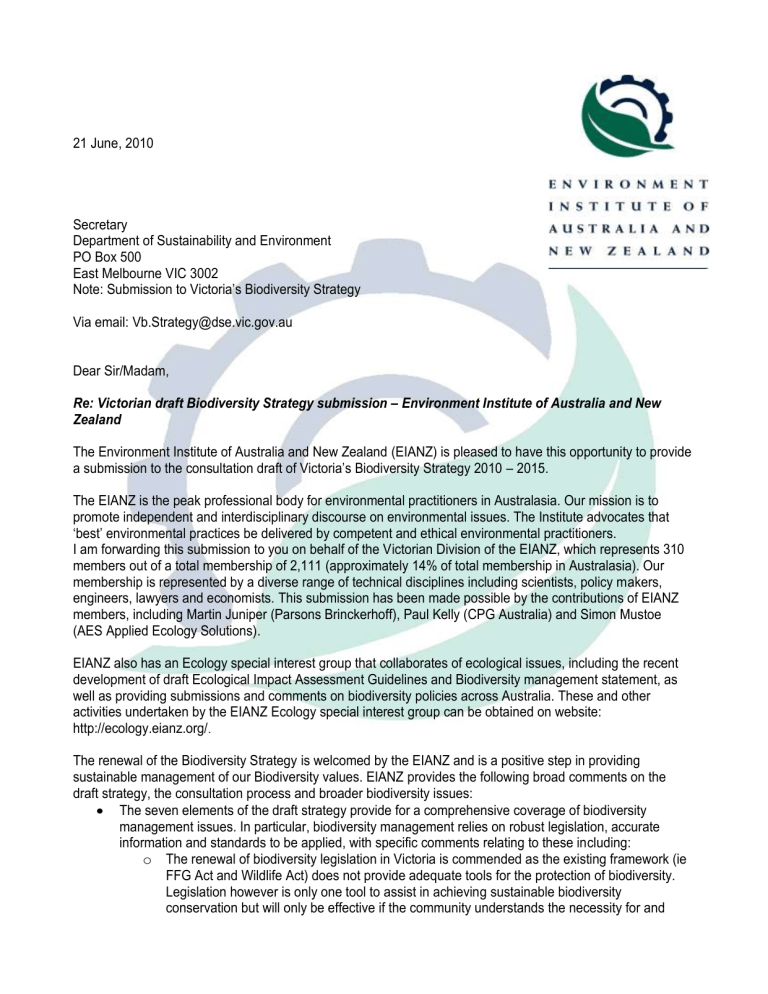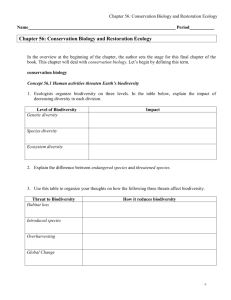1 July 2008 - Environment Institute of Australia and New Zealand

21 June, 2010
Secretary
Department of Sustainability and Environment
PO Box 500
East Melbourne VIC 3002
Note: Submission to Victoria’s Biodiversity Strategy
Via email: Vb.Strategy@dse.vic.gov.au
Dear Sir/Madam,
Re: Victorian draft Biodiversity Strategy submission – Environment Institute of Australia and New
Zealand
The Environment Institute of Australia and New Zealand (EIANZ) is pleased to have this opportunity to provide a submission to the consultation draft of Victoria’s Biodiversity Strategy 2010 – 2015.
The EIANZ is the peak professional body for environmental practitioners in Australasia. Our mission is to promote independent and interdisciplinary discourse on environmental issues. The Institute advocates that
‘best’ environmental practices be delivered by competent and ethical environmental practitioners.
I am forwarding this submission to you on behalf of the Victorian Division of the EIANZ, which represents 310 members out of a total membership of 2,111 (approximately 14% of total membership in Australasia). Our membership is represented by a diverse range of technical disciplines including scientists, policy makers, engineers, lawyers and economists. This submission has been made possible by the contributions of EIANZ members, including Martin Juniper (Parsons Brinckerhoff), Paul Kelly (CPG Australia) and Simon Mustoe
(AES Applied Ecology Solutions).
EIANZ also has an Ecology special interest group that collaborates of ecological issues, including the recent development of draft Ecological Impact Assessment Guidelines and Biodiversity management statement, as well as providing submissions and comments on biodiversity policies across Australia. These and other activities undertaken by the EIANZ Ecology special interest group can be obtained on website: http://ecology.eianz.org/
.
The renewal of the Biodiversity Strategy is welcomed by the EIANZ and is a positive step in providing sustainable management of our Biodiversity values. EIANZ provides the following broad comments on the draft strategy, the consultation process and broader biodiversity issues:
The seven elements of the draft strategy provide for a comprehensive coverage of biodiversity management issues. In particular, biodiversity management relies on robust legislation, accurate information and standards to be applied, with specific comments relating to these including: o The renewal of biodiversity legislation in Victoria is commended as the existing framework (ie
FFG Act and Wildlife Act) does not provide adequate tools for the protection of biodiversity.
Legislation however is only one tool to assist in achieving sustainable biodiversity conservation but will only be effective if the community understands the necessity for and
supports the legislation. This is particularly relevant in situations where personal attitudes to the rights to manage private land are compromised. o Developing standards for biodiversity management, policy and assessment across Victoria is fundamental and the consistency in application through guidelines (eg EIANZ Ecological
Impact Assessment Guidelines and EES guidelines for assessment), practice notes, training and certification of biodiversity practitioners (eg Certified Environmental Practitioner program,
DSE’s habitat hectare accreditation program) is required. Developing these standards should however be done in collaboration with relevant stakeholders (eg EIANZ) o Sharing and consolidating biodiversity information to enable decision makers to make informed and considered policies and management decision relating to biodiversity.
NaturePrint provides actions to capture and share critical information. Implementation of these actions with datasets and online databases managed and co-ordinated carefully is essential to allow up-to-date information to be easily and readily access by environmental professionals and the broader community.
Sustainable conservation of biodiversity cannot be achieved outside of a commercial framework.
Voluntary schemes that do not reflect the real cost of management are unsustainable and rely heavily on the goodwill of the current management. The goodwill, level of interest and engagement changes with a change in management. The motivation to achieve long term biodiversity conservation, changes with management. Achieving sustainable biodiversity conservation on private land, particularly agricultural land will only be achieved where the gross margins from managing for biodiversity conservation exceed other potential enterprises.
Emphasis on the management of threatened species in favour of the integrated management of species and biodiversity as part of prime conservation reserves is an ineffective allocation of resources. Individual species of flora and fauna will continue to be threatened with extinction for as long as we continue to spend a greater proportion of the conservation budget on the research and management of single species, as opposed to biodiversity. Our conservation reserves hold the majority of our biodiversity assets and yet they continue to struggle with inadequate funding to manage ongoing and persistent threats such as pest plant and animal management. Management funding is preferentially directed to public use of the reserves rather than effective conservation management.
Several biodiversity conservation programs go part way to achieving a sustainable biodiversity conservation outcome: o The Bush Tender program partially compensates land owners by supplementing the costs of management. Those projects that are lower in cost to Government will always be favoured over more costly projects. This program is ostensibly voluntary as it does not enable targeted property specific management agreements. o The Land for Wildlife (L4W) program is totally voluntary. While L4W provides a valuable community education program which facilitates cultural change, it has no ability to target specific high impact sites or poorly represented ecosystems. o The BushBroker project more closely reflects market pricing for biodiversity conservation services and provides opportunity for landowners with higher quality remnant native vegetation to provide offsets for the removal of native vegetation. The expansion of this scheme to facilitate sustainable biodiversity conservation on private land by negotiating a commercially acceptable contract would be welcomed.
Victoria’s Native Vegetation – A Framework for Action is a world-leading example of offset management, yet it has become side-tracked by current case precedent, which omits consideration of some of the more important principles of biodiversity. It is not enough to just quantify loss, it is also vital to assess the efficacy of replacement. The Victorian government's policy recognises the full range of principles but many of those that are absolutely essential to a successful biodiversity outcome, are ignored by decision-making authorities. For example, the connectivity of a habitat patch in relation to landscape-scale ecological function is often overlooked, if the habitat patch is small and an offset can
2
be quantified and found elsewhere. Whilst small, the patch may still represent a significant part of the local landscape and be 'irreplaceable' e.g. it may serve a water quality or soil-stability function. By omitting some of these 'biodiversity' considerations, the Framework has become detached from what is now considered best practice for offsets.
Riparian ecosystems are under considerable threat from numerous land management practices. They have the potential to provide a large linear network across whole landscapes of Victoria and provide a valuable service to the management of our water quality. The management of these critically threatened ecosystems would benefit from commercially orientated programs.
The interaction between the draft strategy and the original 1997 version is unclear. The document states that the draft strategy is an amendment to the 1997 version in accordance with the provisions of the Flora and Fauna Guarantee Act 1988, with revised goals and actions, however it is not stated if any of the goals of the original strategy still apply or if the revised draft needs to be read in conjunction with the 1997 version. It is recommended that clarity be made between the links of the original and revised document, with references made throughout the revised document and/or a specific section dedicated to detailing the corresponding sections of the original 1997 version.
The process for consultation has not been clear with minimal publicity surrounding its release and only providing a relatively short timeframe in which to provide comments. It was noted that the release of this draft and consultation process was not advertised on the ‘what’s news’ area DSE’s website during the consultation phase, an area that is likely to be regularly visited by environmental practitioners and the broader community. It is recommended that any future consultation programs provide adequate publicity and timeframes for all key stakeholders to provide submissions.
There are a number of timeframes with the Key Activities tables that are have not been defined. It is unclear if these are to be defined in the finalised version, are yet to be defined or are ongoing actions.
Further to this, it is unclear if each action has been costed, resources identified and allocated to ensure that all commitments are achievable.
EIANZ welcomes any further opportunities to discuss details of this or other draft strategies developed by the
Department.
Yours sincerely,
Elizabeth Hurst
President – Victorian Division
Postal: C/O PO Box 19016, Southbank VIC 3006
Tel: 03 9861 1139 Fax: 03 9861 1144
Web: www.eianz.org
ABN 39 364 288 752
3







